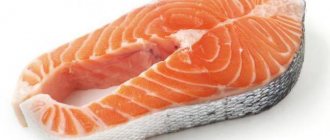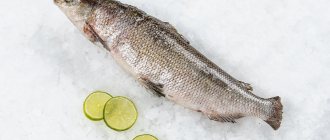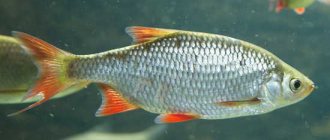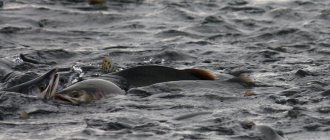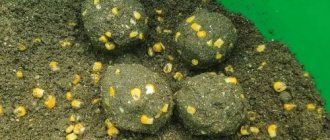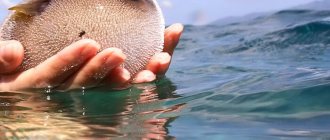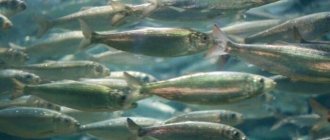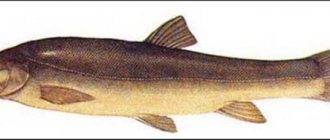Pink salmon is a commercial fish belonging to the Pacific salmon family. It gets its name from the growth that appears on males during the spawning period. The fish's habitat is the cold waters of the Arctic and Pacific oceans.
Pink salmon meat is extremely beneficial for the human body, as it contains a wide range of essential substances (vitamins, protein structures, microelements, fatty acids). With systematic consumption of fish (two to three times a week), the condition of the dermis improves, cerebral circulation is activated, mood improves, and bone tissue is strengthened. In addition, the likelihood of developing stomach ulcers, hypothyroidism, asthma, diabetes, hypertension, arthritis, and allergic diseases is reduced.
General information
Content:
- General information
- Chemical composition
- Beneficial features
- How to choose pink salmon
- Use in cooking
- How to salt fish correctly?
- Note to housewives
- Conclusion
Pink salmon is the smallest and most numerous representative of the salmon family. The average length of an adult varies from 35 to 43 centimeters, and the weight is 1.5 to 2.2 kilograms.
Pink salmon are found in rivers, seas and oceans of the northern hemisphere. The natural habitat of the fish extends from the Siberian Lena River to the coast of the islands of Honshu and Korea, as well as from the Sacramento River (Northern California) to the Canadian Mackenzie Reservoir. In addition, it is found in the Great American Lakes, where it was successfully introduced from the waters of cold seas.
Interestingly, pink salmon is one of the few fish that can live in both salt and fresh water. This phenomenon is associated with the life cycle of salmon.
Mass spawning of pink salmon occurs in river reservoirs on rifts with sand and pebble soil and fast currents from July to September. The fish approaches the breeding site in “nuptial plumage”: the males grow a hump and teeth, enlarge their jaws, and spots appear on the body. After laying eggs, the females die.
The hatched fry live in rivers until the beginning of summer. They then migrate to salty waters, where they mature sexually (within a year). In the middle of next summer, adult individuals return to fresh water bodies for spawning grounds. After laying eggs, the life cycle of pink salmon repeats.
The appearance of salmon directly depends on its habitat. The typical color of fish living in the sea is silver or light blue. After entering the spawning area, its color changes: the abdomen becomes yellowish-white, the body acquires a brown tint, the tail and fins turn black.
Origin of the species and description

Pink salmon is a typical representative of the salmon family, characterized by its relatively small size and high prevalence in the cold waters of the oceans and seas. Refers to anadrobic fish, which are characterized by reproduction in fresh waters and living in the seas. Pink salmon got its name due to the peculiar hump on the back of the males, which is formed with the onset of the spawning period.
Video: Pink salmon
The most ancient ancestor of the pink salmon that exists today was small in size and had a lifestyle similar to the freshwater grayling that lived in the cold waters of North America more than 50 million years ago. The next three tens of millions of years did not leave any noticeable traces of the evolution of this species of salmon fish. But in the ancient seas from 24 to 5 million years ago there were already representatives of all salmonids existing today, including pink salmon.
Interesting fact: All pink salmon larvae are females when they are born, and only just before they slide into the waters of the sea, half of them change their sex to the opposite. This is one of the ways of struggle for existence that nature has provided for this type of fish. Since females, due to the characteristics of their organism, are more hardy, thanks to this “transformation” a larger number of larvae will survive until the moment of migration.
Now you know what pink salmon fish looks like. Let's see where it lives and what it eats.
Chemical composition
Pink salmon is a source of easily digestible protein, polyunsaturated fats (omega-3), B vitamins, micro- and macroelements (sulfur, chromium, phosphorus, cobalt, iodine).
Table No. 1 “Chemical composition of pink salmon”
| Nutrient name | Element content in 100 grams of fish, milligrams |
| Vitamins | |
| Vitamin B4 | 94,5 |
| Vitamin B3/PP | 4,6 |
| Vitamin E | 1,5 |
| Vitamin C | 0,9 |
| Vitamin B5 | 0,75 |
| Vitamin B6 | 0,6 |
| Vitamin B1 | 0,2 |
| Vitamin B2 | 0,16 |
| Vitamin A | 0,03 |
| Vitamin D | 0,01 |
| Vitamin K | 0,004 |
| Macronutrients | |
| Potassium | 335 |
| Phosphorus | 200 |
| Sulfur | 190 |
| Chlorine | 165 |
| Sodium | 70 |
| Magnesium | 30 |
| Calcium | 20 |
| Microelements | |
| Zinc | 0,7 |
| Iron | 0,6 |
| Fluorine | 0,43 |
| Copper | 0,11 |
| Chromium | 0,55 |
| Iodine | 0,05 |
| Manganese | 0,05 |
| Selenium | 0,045 |
| Cobalt | 0,02 |
| Nickel | 0,006 |
Table No. 2 “Nutritional value of pink salmon”
| Name | Amount in 100 grams of fish, grams |
| Water | 75,5 |
| Squirrels | 20,5 |
| Fats | 6,5 |
| Ash | 1,5 |
| Monounsaturated fats | 1,3 |
| Saturated fats | 1,1 |
| Polyunsaturated fats | 0,81 |
| Carbohydrates | 0 |
However, you should not overuse fish meat, since 100 grams of pink salmon contain up to 60 milligrams of cholesterol, which poses a danger to people with heart and vascular diseases.
Calorie content of fish
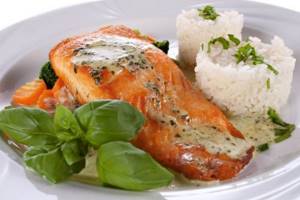
100 grams of raw product contains 140 kcal, which is especially valuable for those who try to keep in shape. With such a low calorie content, it is quite nutritious. Due to the large amount of protein, this fish will quickly fill you up, because digestion in the gastrointestinal tract is slow, and the feeling of hunger will not arise quickly.
What can you cook from pink salmon?
Cooking salmon is easy. The tissue of the fish is dense, delicate, and easy to process and fillet.
For example, for soup you can use the head and tail parts, fins, or cook fish soup, which is suitable for dietary nutrition.
Pink salmon can be salted, smoked, fried, boiled and baked. There is an opinion that cooking changes the calorie content of the product. Is it really?
Pay attention to the table that shows the calorie content of dishes made from this fish.
The ratio of cooking methods and calorie content of pink salmon per 100 g of finished product
Pink salmon/calorie content kcal per 100 g

Beneficial features
Pink salmon is a record holder for the content of omega-3 fats, which have anti-inflammatory, oncoprotective, bioregulatory, immunomodulating, hypocholesterolemic, antiarrhythmic and cardioprotective effects on the body. Fish also contains amino acids and antioxidants that have a beneficial effect on the human body.
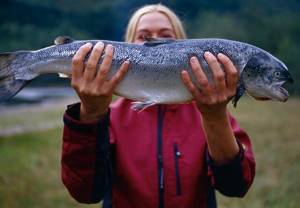
Beneficial properties of salmon:
- Reduces the likelihood of developing malignant tumors, stabilizes the activity of cell membranes, prevents the formation of blood clots (omega-3 acids, protect DNA cells from the action of free radicals, gene mutations and the adhesion of exogenous deposits to the walls of blood vessels).
- Normalizes water-salt metabolism (due to the content of potassium, sodium and magnesium).
- Improves the appearance of skin, nails, hair (fat-soluble vitamins, essential lipids and microelements prevent dehydration of the dermis).
- Maintains rheological blood parameters (sodium, potassium, fluorine, zinc are involved in hematopoiesis processes).
- It has an anti-inflammatory effect on the body, prevents the development of autoimmune diseases (pink salmon owes this effect to riboflavin, zinc and polyunsaturated fatty acids).
- Accelerates the regeneration of intracellular structures, tissues and organs of the body (B vitamins, omega-3, iodine, sodium, zinc, selenium and phosphorus are involved in the formation of enzymes that accelerate the processes of rejuvenation of the body).
- Protects dental tissue from caries (fluoride strengthens enamel).
- Normalizes the functioning of the central nervous system, improves cerebral circulation, improves mood (due to the presence of B vitamins and magnesium).
- Stimulates the endocrine glands, prevents the development of iodine deficiency (due to the content of iodine, copper, selenium, zinc and manganese).
- Increases hemoglobin, saturates body cells with oxygen (since it contains iron and vitamin C).
- Strengthens blood vessels, prevents the formation of wrinkles (flavonoids, antioxidants and fat-soluble vitamins increase the elasticity of connective tissue).
- Prevents the development of obesity (phosphorus stimulates chemical reactions in cells, as a result of which the metabolic rate increases).
- Improves the functioning of the digestive tract (due to the content of vitamin PP, thiamine, pantothenic acid and zinc).
- Accelerates the regeneration of bone tissue, strengthens muscles, protects the skeleton from destructive changes (due to the presence of calcium, zinc and phosphorus).
- Regulates blood sugar concentration (chromium and polyunsaturated fats increase cell sensitivity to insulin).
- Potentiates the synthesis of enzymes necessary for the functioning of the body (zinc, vitamin PP, thiamine, pyridoxine, biotin, manganese, copper are “responsible” for the formation of hormones).
- Protects nerve cells from destruction, accelerates the restoration of damaged tissues (due to the presence of choline and histidine).
- Stimulates the production of your own collagen (due to the presence of sulfur, zinc and copper).
It is recommended that all categories of the population eat pink salmon twice a week, 150–300 grams per meal, depending on age, body weight, and health status.
People suffering from autoimmune and iodine deficiency diseases, schoolchildren, students, pregnant and lactating women should increase their fish consumption to three to four times every 7 days.
It is interesting that for residents of the Far North, where there is a shortage of sunlight, pink salmon is an indispensable product because it contains vitamins D and B12, which prevent the occurrence of rickets in infants.
Fish consumption is limited when:
- chronic liver pathologies;
- ulcers of the gastrointestinal tract;
- diseases of the kidneys and urinary system;
- allergic reactions to seafood.
In addition, if a person has hyperthyroidism or fluorosis, pink salmon is completely excluded from the daily menu (due to the high iodine and fluorine content).
Description of the fish
Pink salmon belongs to the group of Pacific salmon. The habitat of these fish occupies the entire northern part of the Pacific Ocean: from California and Alaska to Kamchatka, the Kuril Islands, Sakhalin and the northern islands of the Japanese archipelago. Through the Bering Strait they penetrate into the seas of the Arctic Ocean: Chukchi, East Siberian and Beaufort.
All Pacific salmon are anadromous fish. This means that their birth and growth occur in rivers and at the fry stage they are freshwater; as they grow, the juveniles descend down the rivers into the ocean, and adults, having gone through a series of morphological changes, become real marine inhabitants. A fish can undergo such profound transformations only once, so Pacific salmon also spawn once in their lives, traveling many hundreds of kilometers to spawning grounds upstream of rivers, where they die. The lifespan of Pacific salmon in natural conditions is relatively short - 3-4 years.
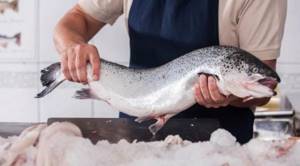
At the marine stage of life, fish actively feed and grow, swimming in a layer of water up to 10 m deep in the open ocean, in the zone where waters are mixed by ocean currents. They do not form large flocks or shoals. As the water warms up, in spring and early summer, fish migrate to the coasts and find themselves near river mouths. Sexually mature individuals go into the rivers, and the young of the year return to the open ocean as the weather gets colder.
Pacific salmon spawn in the same rivers where they themselves were born, while their body undergoes a number of irreversible changes. The nuptial coloration appears, the body of the fish thickens, the jaws become curved, and powerful, curved back teeth grow on them. Thin skin with small scales is replaced by a skin that is durable due to ingrown scales.
Changes occur in individuals of both sexes, but in males they are more pronounced. Moving upstream in rivers, fish do not feed, losing energy accumulated in fat reserves and muscles. The digestive organs atrophy.
At the spawning grounds, they manage to spawn, fertilize and bury eggs in the ground, after which they die. The flesh of salmon going to spawn and spawning almost completely loses its taste and nutritional qualities. After about 2 months, the fry hatch from the eggs and live under a layer of soil until the gall sac is reabsorbed, after which they go out into the water and are usually carried out to sea by the current next summer. In rivers and fresh flowing lakes, juveniles can remain for 1-3 years.
How to choose pink salmon
Today, on store shelves, fish is presented both whole and cut. However, more and more often, uneviscerated carcasses are stored in inappropriate conditions, and spoiled goods are hidden under the guise of steaks, fillets or backs.
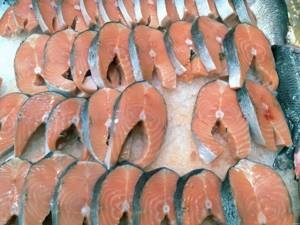
Useful tips for choosing pink salmon:
- Fresh fish have a pink belly, while old fish have a yellow belly.
- The gills of recently caught pink salmon are bright red (odorless). If greenish mucus is visible on the organs, this indicates that the carcass has begun to deteriorate.
- When purchasing uncut or frozen fish, carefully inspect the tail, fins and head. These organs are the main indicators of product freshness.
Repeated freezing is indicated by a dry, “windy” tail (with damaged structure), a slightly open mouth and sunken eyes.
- A chilled carcass has clean, smooth skin, without damage, bends or stains, tightly adjacent to the meat. The scales of such a fish are silvery and shiny, firmly attached to the body. If the skin easily comes away from the flesh, the product has been stored on the shelves for a long time, it is better to refuse to purchase such seafood.
- The meat of fresh pink salmon is colored soft pink. Whitened fillet “indicates” repeated freezing or improper storage of the product.
- The muscles and back of the seafood should be firm to the touch. If pressure from your finger leaves a dent, the fish is rotten.
- When choosing salmon, do not pay attention to the brightness of the eyes. For fish that have gone through at least one freezing cycle, they are always cloudy.
- Newly caught pink salmon always sinks in the water and does not bend in the palm of the hand.
Remember, frozen fish simplifies the cooking process, speeds it up, but significantly complicates the ability to determine the quality of the product.
Natural enemies of pink salmon
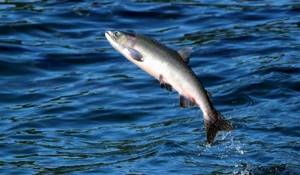
Photo: Female pink salmon
In their natural environment, pink salmon have more than enough enemies:
- caviar in huge quantities is destroyed by other fish, such as char, grayling;
- Seagulls, wild ducks, and predatory fish are not averse to feasting on the fry;
- adult individuals are included in the usual diet of beluga whales, seals, and herring sharks;
- at spawning grounds they are eaten by bears, otters, and birds of prey.
Fun fact: More than 37 percent of the world's Pacific salmon catches are pink salmon. The world catch of this type of fish in the eighties of the last century averaged 240 thousand tons per year. The share of pink salmon in the total salmon fishery in the USSR was about 80 percent.
In addition to enemies, pink salmon have natural competitors that can take over some of the food that salmon are accustomed to. Under some circumstances, pink salmon itself can cause a decline in the population of other fish species or even birds. Zoologists have noticed a connection between the increased population of pink salmon in the North Pacific Ocean and the decline in the number of slender-billed petrels in the southern part of the Ocean. These species compete with each other for food in the north, where petrels stop for the winter. Therefore, in the year when the pink salmon population grows, the birds do not receive the required amount of food, as a result of which they die during their return to the south.
Use in cooking
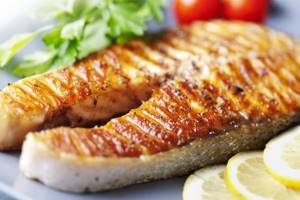
Due to its prevalence and low cost, pink salmon is successfully used in cooking. The fish meat is dense. It is ideal for boiling, frying, baking, stewing, pickling, pickling, canning and smoking.
Subtleties of culinary processing of pink salmon:
- To prepare first courses, it is better to purchase a whole fish, and to create side dishes, appetizers, and delicacies - a carcass without a head.
- Before frying, pink salmon is soaked for 20 minutes in olive oil and then coated with mayonnaise or your favorite sauce. This treatment will help prevent the fillet from drying out.
- If, while cooking the fish, the carcass is sprinkled with lemon or orange juice (2-3 times), the seafood will acquire a piquant citrus flavor.
- When processing pink salmon, it is important not to overdo it with spices (so as not to “interrupt” the exquisite taste of salmon). Seafood goes well with allspice, vegetable oil, lemon juice, and sour sauces.
- Before preparing the whole carcass, the gills are removed from the head. If they are not removed, the product will acquire a bitter taste.
- Fatty varieties of pink salmon are baked without oil, while lean ones, on the contrary, add it.
- Stewed or fresh vegetables are served as a side dish for fish.
- Pink seafood caught in the sea or ocean is used as food. During the spawning period, pink salmon meat turns white, losing its taste.
The calorie content of pink salmon varies from 140 to 200 kilocalories per 100 grams of product, depending on the cooking method. Thus, the energy value of raw fish is 140 kilocalories, boiled - 150 kilocalories, baked - 160 kilocalories, lightly salted - 169 kilocalories, fried - 200 kilocalories.
Due to its low fat content and low calorie content, pink salmon is considered a dietary product.
Where do pink salmon live?
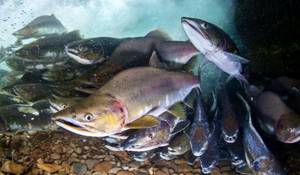
Photo: Pink salmon in water
Pink salmon are found in large quantities in the North Pacific:
- along the Asian coast - from the Bering Strait to Peter the Great Bay;
- along the American coast - to the capital of California.
This species of salmon lives off the coast of Alaska, in the Arctic Ocean. Pink salmon are found in Kamchatka, the Kuril Islands, Anadyr, the Sea of Okhotsk, Sakhalin and so on. It is found in Indigirka, the lower Kolyma up to Verkhne-Kolymsk, does not enter the Amur very high, and is not found in Ussuri. The largest stocks of pink salmon live in the Pacific Ocean, where during feeding time the American stock mixes with the Asian stock. Pink salmon are even found in the waters of the Great Lakes, where a small number of individuals are found by accident.
Pink salmon spend only one summer and winter at sea, and in the middle of the second summer they go to rivers for subsequent spawning. Large individuals are the first to leave the waters of the sea, and gradually during migration the size of the fish decreases. Females arrive at the spawning site later than males, and by the end of August the pink salmon run stops, and only the fry return to the sea.
Interesting fact: The most impressive representative of the ancient salmon family is the extinct “saber-tooth salmon”, which weighed more than two hundredweight, was about 3 meters long and had five-centimeter fangs. Despite its rather menacing appearance and impressive size, it was not a predator, and its fangs were only part of the “mating plumage.”
Pink salmon feels great in cold waters with temperatures from 5 to 15 degrees, the most optimal being about 10 degrees. If the temperature rises to 25 and above, the pink salmon dies.
How to salt fish correctly?
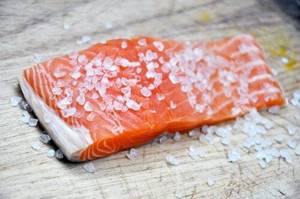
Lightly salted pink salmon is an exquisite snack option for both everyday and festive tables. Currently, there are many recipes for salting salmon meat. Therefore, housewives often have a question: how to properly cook fish at home?
“Wet” method of salting fish
- Gut the carcass. To do this, the fish is thawed at room temperature for 5 hours. After defrosting, the product is cut up: the head, tail, fins are removed, the skin is removed, the abdomen is ripped open, and the entrails are removed. Then the carcass is washed under running water and the fillet is separated from the backbone and bones.
- Cut the prepared meat into portions.
- Prepare a pickling solution. To do this, pour 60–75 milligrams of coarse table salt (4–5 tablespoons) into a liter of cooled boiled water. The mixture is thoroughly mixed.
- Place the pink salmon fillet in the brine for 20 - 40 minutes. The length of time the fish is kept in the salt solution depends on the individual preferences of the family.
- Remove the pink salmon pieces from the brine and place on a paper towel.
- Place the seafood in a glass jar and put it in the refrigerator.
The finished product is stored for no more than 5 days at a temperature of + 4 degrees Celsius.
To increase shelf life, fish is lubricated with vegetable oil.
Classic recipe for dry pickling
- Divide the prepared pink salmon into 2 parts (without removing the film from the skin).
- Sprinkle the fillet with salt (at the rate of 45 grams of spice per kilogram of seafood).
- Place both parts of the fish on a cotton cloth (meat side down).
- Wrap the carcass in material and then place in an airtight container.
- Place the container with pink salmon in the refrigerator for 14–15 hours.
After salting is completed, the fish is cleaned of any remaining salt and sprinkled with olive oil.
Recipe for dry pickling pink salmon with spices
Ingredients:
- pink salmon – 1 kilogram;
- coarse sea salt – 75 grams;
- sugar – 30 grams;
- lemon juice – 15 milliliters;
- ground black pepper – 5 grams;
- fresh parsley - a sprig;
- bay leaf - 3 pieces.
Cooking principle:
- Cut the prepared carcass into 2 parts (without removing the film from the skin).
- Mix salt, sugar and black pepper.
- Rub both sides of the fillet with the seasoning mixture, and then place the fish in an enamel or glass container.
- Place bay leaf and herbs on top of the seafood and sprinkle with lemon juice.
- Cover one half of the pink salmon with the other.
- Seal the container and refrigerate for 48 hours.
- Turn the fillets twice daily.
After two days, remove the remaining salt using a paper napkin. The fish is ready to eat!
How to remove skin from fish
The skin must be removed carefully so as not to catch the sirloin. To do this, you need to start removing from the tail and only after you have completed all the manipulations to remove large bones. It is necessary to carefully monitor the meat so that it does not stick to the skin; use a sharp knife to trim in those places where the carcass does not come off well.
Chefs have an interesting trick: when the fillet is ready, the skin is not removed. Cut a double piece of fish on the skin and divide it in half. Without cutting the skin, turn it inside out. The fillet will be on the outside, and the skin will be completely inside, like a frame. This way the fish is baked perfectly and does not fall apart.
Note to housewives
Let's look at popular recipes for preparing fish dishes.
Pink salmon baked with tomatoes

Ingredients:
- pink salmon – 900 – 1000 grams;
- onions – 2 heads;
- lemon juice – 15 milliliters;
- tomatoes – 3 – 4 pieces;
- ketchup – 15 milliliters;
- mayonnaise – 45 milliliters;
- vegetable oil – 15 – 30 milliliters;
- salt - to taste.
Cooking method:
- Cut the fish into steaks.
- Soak seafood in lemon juice for 10 minutes.
- Peel and chop tomatoes and onions.
- Season the vegetables with a mixture of mayonnaise and ketchup.
- Grease a baking dish with oil.
- Lay pink salmon, tomatoes and onions in layers.
- Bake the fish for 45 minutes at 180 degrees.
The finished pink salmon turns out juicy with a crispy crust.
Fish baked in foil
Ingredients:
- pink salmon (whole carcass);
- lemon – 1 piece;
- a mixture of freshly ground peppers – 5 grams;
- salt, seasonings (to taste).
Cooking sequence:
- Cut the pink salmon: remove the head, fins, and entrails.
- Rinse the carcass under running water.
- Prepare the marinade: mix salt, pepper, seasonings, mayonnaise, lemon juice.
- Coat the fish with the mixture and leave to marinate for 3 – 4 hours.
- Place lemon half rings inside the belly.
- Wrap the carcass in foil (tightly) and place in an oven preheated to 180 degrees for 30 minutes.
When serving, decorate the dish with herbs.
Pink salmon soup

Ingredients:
- pink salmon – 1 piece;
- water – 2.5 liters;
- onion – 1 head;
- potatoes - 4 pieces;
- carrots – 1 piece;
- ground pepper, salt - to taste.
Step by step recipe:
- Cut and wash pink salmon thoroughly.
- Cut the fish into steaks. Remove the gills from the head. Cut the fillet from the backbone, salt it and put it in the refrigerator
- Prepare the broth. To do this, place the head, tail and fins of the fish in boiling water. Boil the broth for 30 minutes over medium heat, constantly skimming. The finished fish broth is filtered through cheesecloth or a fine sieve.
- Prepare vegetables and spices. The onions are peeled and cut into 2 parts, which are fried in a dry frying pan.
For fish soup, it is better to choose allspice rather than hot peppers (so as not to drown out the delicate aroma of the fish).
- Peel and cut carrots and potatoes.
- Place the strained broth on the stove and bring to a boil.
- Add vegetables, seasonings, and, if desired, rice or millet to the fish broth. After boiling, add salted pink salmon fillet to the broth.
- Cook the fish soup over low heat until the potatoes are ready (15 - 20 minutes).
- Add salt 5 minutes before the dish is ready.
Interestingly, traditional fish soup contains only fish and broth (without the addition of vegetables, cereals and seasonings).
Stuffed pink salmon
Ingredients:
- pink salmon (whole carcass with head) – 1.8 kilograms;
- tomatoes - 3 pieces;
- eggs – 6 pieces;
- salt – 5 grams;
- cheese – 100 grams;
- salt, spices - to taste.
Cooking principle:
- Cut the fish (do not cut off the head), remove the gills, and rinse the carcass thoroughly.
- Remove the rib bones through the hole in the abdomen (using a thin knife).
- Remove the spine through an abdominal incision (cutting through the bone at the tail and base of the head).
- Salt the fish from the inside of the carcass.
- Prepare the filling. To do this, crushed tomatoes are combined with raw eggs, salt, and spices. The mixture is poured into a shallow container (with sides) and placed in a well-heated oven (for 10 - 15 minutes). Thin slices of cheese are placed on top of the finished omelette.
- Cover the abdominal cavity of pink salmon with sliced cheese.
- Roll the omelette into a roll and place it in the belly of the fish (on top of the cheese).
- Secure the belly with toothpicks and place the seafood on a baking sheet.
- Bake pink salmon at 180 degrees for 40 - 50 minutes.
You can add additional shine to the fish using vegetable oil, which is used to lubricate the carcass 20 minutes after the start of cooking.
Pink salmon and diet
During a diet, pink salmon will be an excellent alternative to meat dishes. It is nutritious and satisfying, contains a lot of healthy protein, but its calorie content is low.
If you are on a diet and want to include pink salmon in your diet, you probably have a question about how to cook it. Fish can be prepared in different ways, but not all of them are suitable for dietary nutrition. Let's take a closer look:
- Boiled and steamed pink salmon is lower in calories, and can be eaten even while on the strictest diet.
- Pink salmon baked in the oven has a low calorie content, only 128 kcal per 100 g. And if you cook the fish in foil, then all the beneficial substances will be fully preserved.
- Canned pink salmon will be useful only if it is cooked in its own juice, without adding oil, tomato or other additives.
But smoked, fried and salted pink salmon will have to be abandoned, since the product prepared in such ways will not bring any benefit, but will lead to swelling, the accumulation of carcinogens and salt in the body.
People who are trying to lose weight wonder when to eat pink salmon for its benefits. There are several tips to keep in mind while dieting:
- Since fish is digested well, but slowly, it is not recommended to eat it at night. It is ideal to consume the product 3-4 hours before bedtime. The best time to eat fish is lunch.
- Nutritionists do not recommend eating pink salmon more than twice a week. As a rule, this is enough to saturate the body with microelements and vitamins.
- If you include pink salmon in the menu, then you need to choose the right side dish for it. For example, potatoes, mushrooms and eggplants will clearly be superfluous: they overload the dish. It is better to choose a side dish of boiled vegetables such as carrots, cauliflower, and broccoli for pink salmon. Fresh vegetables are also suitable: bell pepper, tomato, cucumber. For cereals, give preference to brown rice.
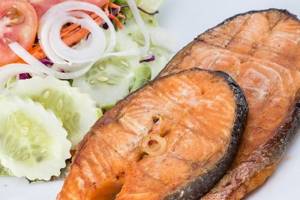
© ueapun – stock.adobe.com
If you lose weight and consume it correctly, pink salmon will not only benefit the body, but also improve your well-being.
Pink salmon spawning
Pink salmon spend a significant part of their life migrating. In autumn and winter it lives in the ocean, and in the spring it goes to spawn, the beginning of which depends on climatic conditions. On Sakhalin, this fish begins to spawn in June, on Kamchatka - in July, in other regions, spawning occurs in August. During a long and grueling journey, pink salmon, rushing towards their goal, loses their vigilance and becomes easy prey not only for fishermen, but also for carnivorous animals.
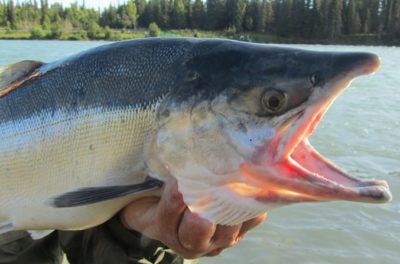
Having reached the place where they themselves were born, the fish begin to prepare to perform the most important function in their lives. Females make small depressions in the bottom surface with their fins and lay eggs in them, after which, together with the males, they bury the nests with sand. By the way, ichthyologists still cannot explain how adult individuals unerringly find their way to where they were born. There are several hypotheses - the fish finds its native place by smell, by the composition of the water, by the features of the bottom, and so on.
The fry appear almost three months later. They do not rush into salty sea waters and remain in the river until spring. During this time, the fish grow up to 3 cm in length, form numerous schools, and then begin a path filled with dangers. Many underwater inhabitants, both river and sea, are not averse to feasting on juvenile pink salmon.
Over the course of 2-3 years, young individuals feed intensively and gain strength in order to return to their “native lands” and repeat the fate of their parents - breed offspring and die. It should be noted that not every pink salmon spawns only once. Such mortality is typical for the Baltic and northern varieties, but females living in the Atlantic Ocean can spawn up to 3 times.
Pink salmon milk: benefits and harms
The milk of this fish has a special taste. This product improves the functioning of the liver and reduces the influence of ultraviolet rays.
Those who often consume the milk of this fish note an increase in stamina and a slowdown in the aging process.
The product has an anti-inflammatory effect. At the same time, the risk of developing atherosclerosis decreases. Even children are allowed to eat milk.
This product can cause harm only if consumed excessively, especially when salted. You can eat no more than 150 grams of milk per day.
Canned pink salmon: benefits and harms
Canned fish is rich in Vitamin B3 and PP, nicotinic acid and Omega-3. It is considered a dietary product and can be used for weight loss.
1. Helps normalize blood cholesterol levels.
2. Thanks to the dilation of blood vessels, blood supply to all human organs improves.
3. Helps remove toxins from the body, participates in the breakdown of fats, proteins and carbohydrates.
4. Prevents the occurrence of inflammatory processes in the body.
This product can only be harmful if the person is allergic to canned foods. Use is not recommended for diseases of the stomach and liver during exacerbation.
Population and species status
Experts prove that there is no threat of extinction of the humpback fish as a species. This is explained by the ability of the smallest representative of salmon to give rise to significantly numerous offspring. Neither natural (climate) changes, nor the main enemies, nor industrial catches can globally influence the decline in the pink salmon population. There are also special incubators that raise and release fry. Therefore, there is no need to breed red fish in unnatural conditions, since the status of this species of salmonids is stable.
Did you know? Chromium, found in pink salmon meat, regulates blood sugar and enhances the functioning of insulin in diabetes mellitus. It is enough to eat 100 g of the finished product to replenish your daily supply of useful microelements.
Pink salmon: benefits
1. Since pink salmon contains calcium, the product helps strengthen bone tissue and also protects the body from the harmful effects of toxins.
2. Supports the functioning of the gastrointestinal tract. Since the substances in the product create protection for the mucous membrane of the stomach and other organs, if you systematically eat fish meat, the functioning of the nervous system will improve.
In particular, stress resistance increases and the risk of depression decreases.
3. The product helps restore the normal amount of adipose tissue in the subcutaneous layer. This is reflected in the firmness and elasticity of the skin. Scientists have found that by consuming the meat of this fish, you can fight cellulite.
4. Pink salmon contains a whole complex of vitamins necessary to maintain the normal condition of nails and hair.
5. The product strengthens the cardiovascular system. It should be eaten to prevent thrombosis, strokes, and heart attacks.
6. It is believed that the meat of this fish can prevent diseases such as gastritis, ulcers, hypertension, asthma, and diabetes. To do this, you need to eat at least 70 grams of fish per day.
7. It has a glycemic index of only 54 units, so it is allowed to be used for diabetes of any type. Preferably baked or stewed.
For women
It is important to consume pink salmon for the fairer sex. The product contains folic acid, which is vital for the functioning of the reproductive system. Folic acid is especially important during pregnancy.
If you regularly eat fish, your hair, teeth, and nails will remain healthy. In addition, if a woman eats pink salmon meat, she is better able to withstand stress.
The product normalizes the functioning of the genitourinary system. This reduces the risk of cystitis and normalizes hormonal levels.
For men
This fish also benefits men. The product is able to maintain male strength, strengthens potency and improves sperm quality. Doctors often ask infertility patients to eat pink salmon.
In addition, it enhances the growth of muscle mass. Heart function improves, which is important for males who experience heavy physical activity.
When breastfeeding
Fish should be consumed with caution while breastfeeding. This is due to the fact that it can cause an allergic reaction. However, it is useful not only for the mother’s body, but also for the baby.
For children
It is advisable to introduce fish into your diet when the baby is more than 7 months old. The product supports vision and strengthens tooth enamel. Pink salmon meat should be given to a child to prevent rickets.
For weight loss
Fish has a very low calorie content, which allows it to be used in dietary nutrition. Even if you eat the product in small quantities, the body receives saturation and the necessary energy for life.
Pink salmon contains substances that provide a normal amount of subcutaneous fat. But in order to lose weight, they eat fish with minimal heat treatment. It is preferable to stew or bake.
Milk increases endurance, slows down the aging process
How to cook delicious pink salmon
Pink salmon is cooked in a frying pan, in a slow cooker, on the grill, snacks, salads, soups, and salt are prepared from it. It goes perfectly with vegetables.
Many people love the classic side dish in the form of potatoes, while others serve fish with lettuce, pepper, cucumber, rice vermicelli, stewed cabbage, and cereal.
Experienced chefs say that to best preserve the taste, it should be baked whole. Before baking or frying, the product is marinated.
Pink salmon is a small-boned fish, it has only a thick bone-spine and thick bones-ribs. There are small bones in pink salmon, but there are very few of them. Its meat has a delicate taste. However, if it is not prepared correctly, the product will be dry.
I recommend:
How to pickle pink salmon and pink salmon caviar - the simplest and most delicious recipes
